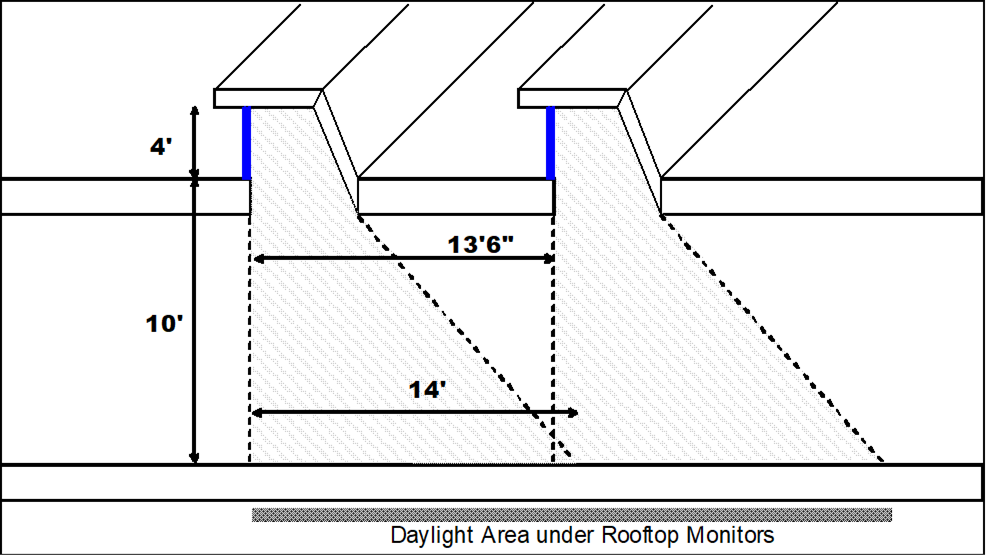
This section contains information about the prescriptive nonresidential indoor daylighting control requirements in the Secondary Sidelit Daylight Zone, and the prescriptive requirements for minimum daylight area in large enclosed spaces directly under a roof.
The prescriptive daylighting requirements are 'in 'addition to the mandatory daylighting controls, which are covered in Section 5.4 of this chapter.
The end of this subchapter also has examples for complying with the mandatory daylighting requirements.
All luminaires providing general lighting that is in, or at least 50 percent in a Secondary Sidelit Daylit Zone as defined in §130.1(d)1C (see Section 5.4.4 2C of this chapter), and that is not in a Primary Sidelit Daylit Zone shall comply with the following:
1. The general lighting shall be controlled independently from all other luminaires (including those in the Primary Sidelit Zone, the Daylit Zone under skylights and lights that are not in Daylit Zones) by automatic daylighting controls that meet the applicable requirements of§110.9; and
2. The general lighting shall be controlled in accordance with the applicable requirements in §130.1(d)2 (see section 5.4.2. of this chapter).
3. All Secondary Sidelit Daylit Zones shall be shown on the plans submitted to the enforcing agency.
EXCEPTIONS:
1. Luminaires in Secondary Sidelit Daylit Zone(s) in areas where the total wattage of general lighting is less than 120 Watts.
2. Luminaires in parking garages complying with §130.1(d)3.
§140.3 has prescriptive requirements for building envelopes, including minimum daylighting for large enclosed spaces directly under roofs. Lighting installed in spaces complying with these prescriptive envelope measures are also required to comply with all lighting control requirements, including the mandatory and prescriptive lighting control requirements.
The mandatory daylighting control requirements are covered in Section 5.4.4 of this chapter.
Thus if one prescriptively complies by installing daylight openings in large enclosed spaces directly under roofs, the daylit areas could have electric lighting systems with high enough lighting power to trigger the mandatory requirements for daylighting controls. However if one complies using the performance approach it is possible to displace the daylighting openings and daylighting controls with other building efficiency options
5.5.2.1 Large Enclosed Spaces Requiring Minimum Daylighting – Qualifying Criteria
The minimum prescriptive daylighting requirements for large enclosed spaces apply to both conditioned and unconditioned nonresidential spaces that meet the following qualifying criteria:
1. Space is directly under a roof
2. Is located in climate zones 2 through 15
3. Has a floor area greater than 5,000 ft²
4. Has a ceiling height greater than 15 ft
EXCEPTIONS:
1. Auditoriums, churches, movie theaters, museums, or refrigerated warehouses.
2. Enclosed spaces having a designed general lighting system with a lighting power density less than 0.5 W/ft2.
3. In buildings with unfinished interiors, future enclosed spaces in which there are plans to have one of the following:
a. A floor area of less than or equal to 5,000 ft2.
b. Ceiling heights less than or equal to 15 feet. This exception shall not be used for S-1 or S-2 (storage) or F-1 or F-2 (factory) occupancies.
4. Enclosed spaces where it is documented that permanent architectural features of the building, existing structures or natural objects block direct beam sunlight on at least half of the roof over the enclosed space for more than 1,500 daytime hours per year between 8 a.m. and 4 p.m.
5.5.2.2 Prescriptive Daylighting Requirements
For large enclosed spaces that are required to comply, following are details of the minimum prescriptive daylighting requirements:
a. A combined total of at least 75 percent of the floor area, as shown on the plans, shall be within the Skylit Daylit Zone or Primary Sidelit Daylit Zone. The calculation of the Daylit Zone area to show compliance with this minimum daylighting requirement does not need to account for the presence of partitions, stacks or racks other than those that are ceiling high partitions. The design of the envelope may be developed before there is any knowledge of the location of the partial height partitions or shelves as is often the case for core and shell buildings. Thus the architectural daylit zone requirement of 75 percent of the area of the enclosed space indicates the possibility of the architectural space being mostly daylit.
The daylit zone and controls specification in §130.1(d) describe which luminaires are controlled. The obstructing effects of tall racks, shelves and partitions must be taken into consideration while determining the specifications. There is a greater likelihood that the electrical design will occur later than the architectural design and thus greater planning for these obstructions can be built in to the lighting circuiting design. With addressable luminaires, the opportunity is available to the contractor to incorporate the latest as built modifications into the daylight control grouping of luminaires according to unobstructed access to daylight.
b.
The
total skylight area is at least 3 percent of the total floor area in the space
within a horizontal distance of 0.7 times the average ceiling height from the
edge of the rough opening of the skylights; or the product of the total skylight
area and the average skylight visible transmittance is no less than 1.5 percent
of the total floor area in the space within a horizontal distance of 0.7 times
the average ceiling height from the edge of the rough opening of
skylights.
The above two requirements can be translated and represented
by the following equations.



Definitions of the above equation terms:
Skylight Area = total skylight area on the roof
Daylit Zone under skylights = total floor area in the space within a horizontal distance of 0.7 times the average ceiling height from the edge of the rough opening of skylights
VT = Visible Transmittance
c. General lighting in daylit zones shall be controlled in accordance with §130.1(d).
d. Skylights shall have a glazing material or diffuser that has a measured haze value greater than 90 percent, tested according to ASTM D1003, or a Commission approved test method.
Skylights must also meet the maximum glazing area, thermal transmittance (U-factor), solar heat gain coefficient (SHGC), and visible transmittance (VT) requirements of §140.3(a). Plastic skylights are required to have a VT of 0.64 and glass skylights are required to have a VT of 0.49. Currently plastics are not accompanied by low emissivity films which transmit light but block most of the rest of the solar spectrum. As a result, there is not maximum SHGC for plastic skylights. Glass skylights are required to have a maximum SHGC of 0.25. With a minimum VT of 0.49 and a maximum SHGC of 0.25, glass skylights must utilize low emissivity films or coatings that have a high light to solar gain ratio.
e. All Skylit Daylit Zones and Primary Sidelit Daylit Zones shall be shown on building plans.
In large buildings which must meet the minimum daylighting requirement, the core zone of many of these spaces will be daylit with skylights. Skylighting 75 percent of the floor area is achieved by evenly spacing skylights across the roof of the zone. A space can be fully skylit by having skylights spaced so that the edges of the skylights are not further apart than 1.4 times the ceiling height. Thus in a space having a ceiling height of 20 feet, the space will be fully skylit if the skylights are spaced so the there is no more than 28 feet of opaque ceiling between the skylights.
The total skylight area on the roof a building is prescriptively limited to a maximum of 5 percent of the gross roof area (§140.3(a)). A number of simulation studies have identified that the optimal skylight area that balances heat gain, heat loss and lighting energy cost savings. These studies have found that savings can be optimized if the product of the VT of the skylight and the skylight to daylit area ratio is greater than 2 percent (this figure accounts for a light well factor of 75 percent and a skylight dirt depreciation factor of 85 percent). If one fully daylights the space with skylights and the skylights meet the prescriptive requirements of 64 percent visible light transmittance, a minimum skylight area of at least 3 percent of the roof area is needed to optimize energy cost savings (see Figure 5-13).
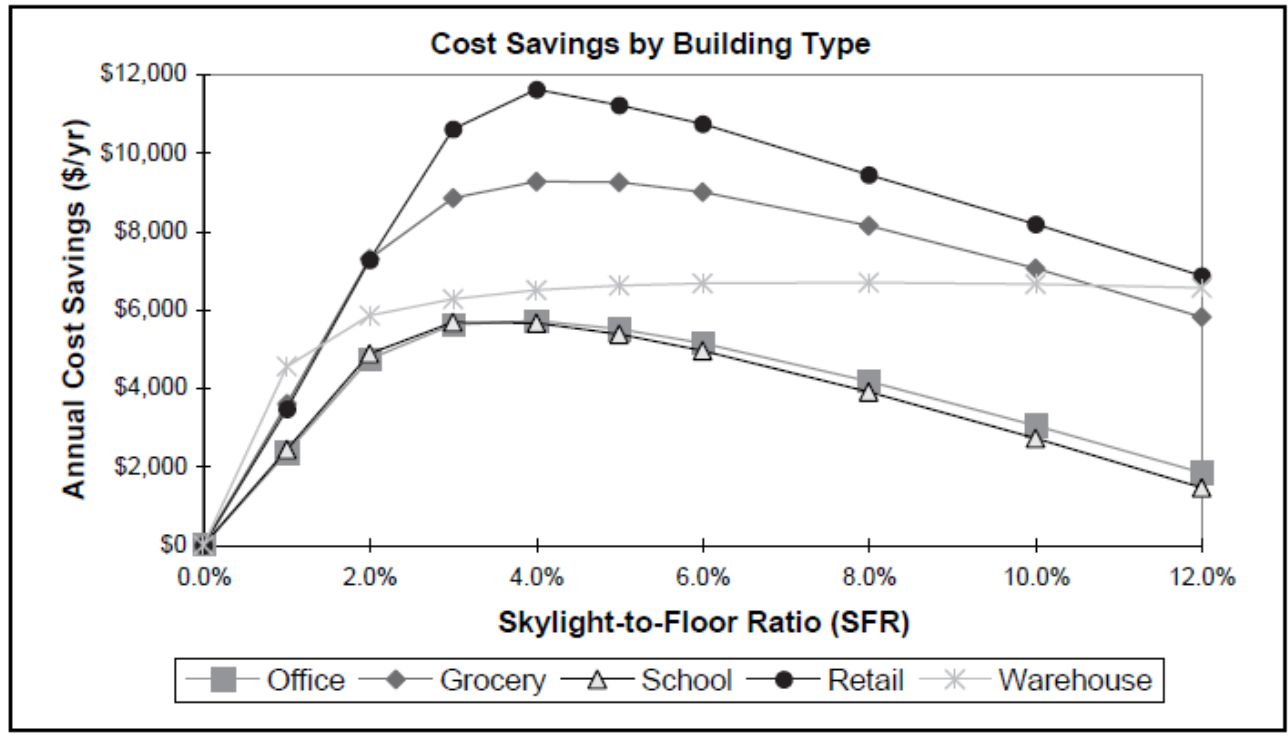
Example 5-5
Warehouse 40,000 square feet area and 30 foot tall ceiling (roof deck)
Maximum skylight spacing distance and recommended range of skylight area
The maximum spacing of skylights that results in the space being fully skylit is:
Maximum skylight spacing = 1.4 x Ceiling Height + Skylight width
Spacing skylights closer together results in more lighting uniformity and thus better lighting quality – but costs more as more skylights are needed. However as a first approximation one can space the skylights 1.4 times the ceiling height. For this example skylights can be spaced 1.4 x 30 = 42 feet. In general the design will also be dictated by the size of roof decking materials (such as 4’ by 8’ plywood decking) and the spacing of roof purlins so the edge of the skylights line up with roof purlins. For this example we assume that roof deck material is 4’ by 8’ and skylights are spaced on 40 foot centers.
Each skylight is serving a 40 foot by 40 foot area of 1,600 square foot. A standard skylight size for warehouses is often 4’ by 8’ (so it displaces one piece of roof decking). The ratio of skylight area to daylit area is 2 percent (32/1600 = 0.02). Assuming this is a plastic skylight and it has a minimally compliant visible light transmittance of 0.65 the product of skylight transmittance and skylight area to daylit area ratio is;
(0.65)(32/1,600) = 0.013 = 1.3 percent
This is shy of the 2 percent rule of thumb described earlier for the product of skylight transmittance and skylight area to daylit area ratio. If one installed an 8 ft by 8 ft skylight (two 4 ft by 8 ft skylights) on a 40 foot spacing would yield a 2.6 percent product of skylight transmittance and skylight area to daylit area ratio. With 64 square feet of skylight area for each 1,600 square feet of roof area, the skylight to roof area ratio (SRR) is 4 percent which is less than the maximum SRR of 5 percent allowed by §140.3(a).
An alternate approach would be to space 4 ft by 8 ft skylights closer together which would provide more uniform daylight distribution in the space and could more closely approach the desired minimum VT skylight area product. By taking the product of the skylight VT and the skylight area and dividing by 0.02 (the desired ratio) yields the approximate area the skylight should serve. In this case with a VT of 0.65 and a skylight area of 32 square feet, each skylight should serve around (0.65*32 /0.02) = 1,040 square feet. A 32 foot center to center spacing of skylights results in (32*32) = 1,024 square feet of daylit area per skylight.
For the minimally compliant 4 ft by 8 ft plastic skylight with a visible light transmittance of 0.65 the product of skylight transmittance and skylight area to daylit area ratio is;
(0.65)(32/1,024) = 0.0203 = 2.03 percent
Example 5-6
Methods for complying with the mandatory daylight control requirements for a space with linear fluorescent luminaires
The Energy Standards require that automatic daylighting controls shall provide functional multi-level lighting levels having at least the number of control steps specified in Table 130.1-A. A minimum of 4 control steps are needed. These steps are identified as:
1 - 20-40 percent; 2 - 50-70 percent; 3 - 80-85 percent; 4 - 100 percent
This can be achieved in one of three ways, using:
1. Continuous dimming - Here the photocontrol gradually dims all luminaires in the daylit zone in response to the available daylight.
2. Stepped dimming with a 4-lamp luminaire - The required control steps can be achieved using a 4-lamp fixture and with two lamps powered by an ON/OFF
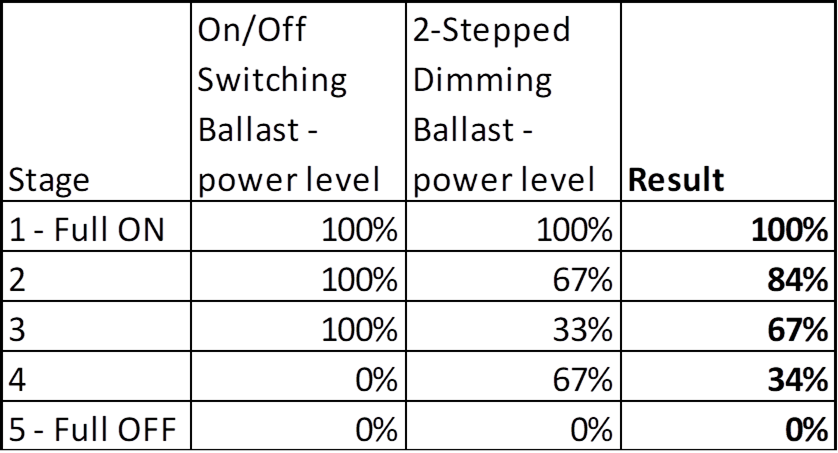
3. Switching alternate lamps in each luminaire, having a minimum of 4 lamps per luminaire. Here the lamps may be tandem-wired such that power to each of the 4 lamps can be controlled separately by the photocontrol based on available daylight.
Example 5-7
Methods for complying with the mandatory daylight control requirements for a space with HID lighting
The Standards require that automatic daylighting controls shall provide functional multi-level lighting levels having at least the number of control steps specified in Table 130.1-A.
A space with HID lamps that are greater than 20 Watts installed power per lamp, shall have a minimum of 1-step between 50 percent and 70 percent.
This can be achieved in one of three ways, using:
A. Continuous dimming - Here the photocontrol gradually dims all luminaires in the daylit zone in response to the available daylight.
B. Stepped dimming - Here the photocontrol signals the stepped dimming ballast to reduce power in incremental steps such there is one control step between 50 percent and 70 percent as noted above.
C. Switching alternate lamps in each luminaire, having a minimum of 2 lamps per luminaire. Here the lamps may be tandem-wired such that power to each lamp in the luminaire can be controlled separately by the photocontrol based on available daylight.
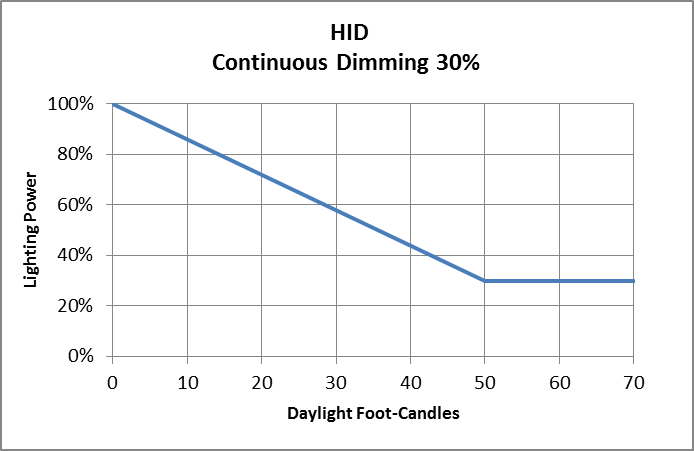
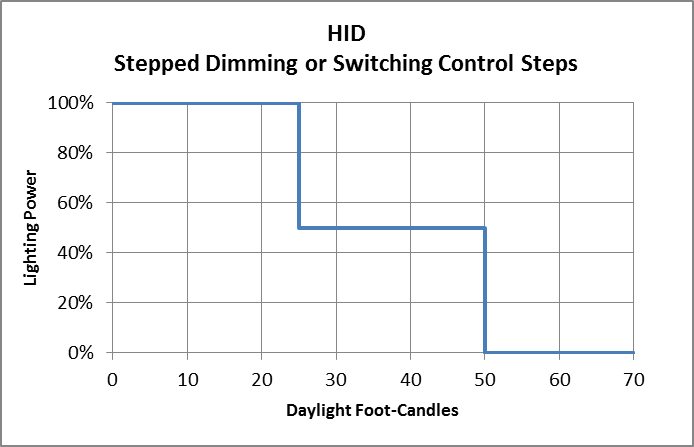
Example 5-8
Complying with the 150 percent of the design illuminance daylighting requirement
When the illuminance received from the daylight is greater than 150 percent of the design illuminance (or nighttime electric lighting illuminance), the general lighting power in the daylight zone must reduce by a minimum of 65 percent.
For example, a space has 500 Watts of installed lighting power in daylit zones. The design illuminance for the space is 50 foot-candle (fc). When the available daylight in the space reaches 75 fc (i.e. 150 percent of 50 fc), then the power consumed by the general lighting in the daylit zones should be 175 Watts or lower.
Without checking all points in the daylit zone served by controlled lighting, verifying that the requirements are met at a worst case location far away from windows or skylights is sufficient. This location is called the “Reference Location”
Example 5-9
Question
Draw the daylit zone for two roof top monitors with four 4 foot long windows projecting over a 10 ft tall roof. The two monitors are 13.5 ft apart.
Answer
Standards currently define skylights as glazing having a slope less than 60 degrees from the horizontal with conditioned or unconditioned space below. Because rooftop monitors have a slope greater than 60 degrees, they are therefore considered to be windows.
